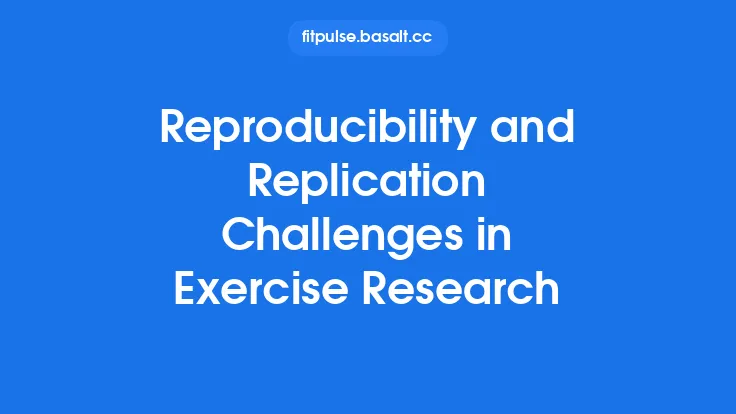Exercise science, like any scientific discipline, relies on the integrity of its research literature to guide practitioners, policymakers, and fellow scientists. Yet the credibility of published findings can be compromised when authors, institutions, or journals have undisclosed or inadequately managed conflicts of interest (COIs) and funding biases. Understanding how these influences arise, how they manifest in the literature, and what strategies exist to mitigate their impact is essential for anyone who depends on exercise‑science evidence. This article provides a comprehensive, evergreen guide to navigating COIs and funding bias in exercise‑science publications, offering practical tools for readers, researchers, and editors alike.
What Constitutes a Conflict of Interest in Exercise Science?
A conflict of interest occurs when a secondary interest—financial, personal, professional, or ideological—has the potential to compromise—or appear to compromise—a researcher’s primary responsibility to produce unbiased, accurate science. In the context of exercise science, common secondary interests include:
| Type of COI | Typical Sources | Potential Influence |
|---|---|---|
| Financial | Grants from equipment manufacturers, supplement companies, sports apparel brands, or fitness‑technology firms | Favorable reporting of product efficacy, selective outcome reporting |
| Professional | Consulting fees, advisory board memberships, speaker honoraria | Preference for methodologies that align with a consultant’s product line |
| Intellectual | Strong theoretical allegiance to a particular training paradigm (e.g., high‑intensity interval training) | Emphasis on data supporting the favored paradigm, down‑playing contradictory evidence |
| Personal | Relationships with co‑authors, mentors, or competitors | Bias in peer review, selective citation practices |
The presence of a COI does not automatically invalidate a study, but transparency about these relationships is crucial for readers to assess the weight of the evidence.
Funding Bias: How Money Shapes Research Outcomes
Funding bias refers to systematic differences in research results that correlate with the source of financial support. In exercise science, this bias can arise through several mechanisms:
- Study Design Choices
- Population selection: Industry‑funded trials may recruit participants who are more likely to respond positively to a product (e.g., elite athletes for a performance supplement).
- Comparator selection: Using a sub‑optimal control condition can exaggerate the apparent benefit of the funded intervention.
- Outcome Selection and Reporting
- Selective outcome reporting: Researchers may prioritize primary outcomes that show significant improvements while relegating null or adverse findings to secondary status or omitting them entirely.
- Spin in abstracts and conclusions: Even when data are presented accurately, language can be framed to highlight benefits and downplay limitations.
- Statistical Analyses
- P‑hacking or data dredging: Conducting multiple analyses until a statistically significant result emerges, especially when the study is funded by a stakeholder with vested interests.
- Use of non‑standard metrics: Choosing proprietary or less‑validated performance measures that favor the funded product.
- Publication Decisions
- Positive‑results bias: Journals may be more inclined to accept studies showing favorable outcomes, especially when the sponsor is a well‑known brand, creating a feedback loop that amplifies funding bias.
Detecting COIs and Funding Bias in Published Articles
While full transparency is the ideal, readers often encounter articles with incomplete disclosures. The following checklist can help identify red flags:
- Disclosure Statements
- Verify that the article includes a dedicated COI section. Absence or vague language (“no conflicts to declare”) warrants further scrutiny, especially if the authors have known industry ties.
- Funding Acknowledgments
- Look for the exact name of the funding agency or corporate sponsor. Funding from “XYZ Sports Nutrition” is more likely to be associated with product‑related bias than a government grant.
- Author Affiliations
- Check whether any authors list corporate affiliations, consulting roles, or patents related to the study’s intervention.
- Study Design Transparency
- Assess whether the methods section details randomization, blinding, and control conditions. Omitted or poorly described methodological elements can mask bias.
- Outcome Reporting Consistency
- Compare the outcomes listed in the trial registration (if available) with those reported in the manuscript. Discrepancies may indicate selective reporting.
- Statistical Rigor
- Examine whether the authors performed appropriate power calculations, corrected for multiple comparisons, and reported confidence intervals alongside p‑values.
- Citation Patterns
- A heavy reliance on self‑citations or citations of other industry‑funded work can suggest a closed citation network that reinforces a particular viewpoint.
Strategies for Researchers to Manage and Disclose COIs
- Pre‑Registration and Protocol Publication
- Register the study on an open platform (e.g., ClinicalTrials.gov, OSF) before data collection. Publish the full protocol, including primary and secondary outcomes, statistical analysis plans, and sample‑size calculations. This creates a public record that can be compared against the final manuscript.
- Full Transparency in Disclosures
- List all financial relationships, even those that seem peripheral (e.g., receipt of free equipment, travel reimbursements). Use standardized disclosure forms when available (e.g., ICMJE COI form).
- Independent Data Monitoring
- When possible, involve an independent data‑safety monitoring board (DSMB) or third‑party statistician to oversee data handling and analysis, reducing the risk of sponsor‑driven manipulation.
- Separate Funding from Data Analysis
- Ensure that the sponsor does not have direct access to raw data or the ability to dictate analytical decisions. Contractual agreements should explicitly state the researcher’s autonomy over data interpretation.
- Open Data and Materials
- Deposit de‑identified raw data, analysis scripts, and measurement tools in a reputable repository (e.g., Zenodo, Figshare). Open materials enable external verification and secondary analyses.
- Balanced Authorship
- Include co‑authors from independent institutions or academic centers who have no financial ties to the sponsor. This can enhance credibility and provide a counterbalance to potential bias.
Editorial and Peer‑Review Safeguards
Journals play a pivotal role in curbing COI‑related bias. Best practices for editors and reviewers include:
- Rigorous COI Screening
- Require authors to complete a detailed COI questionnaire. Cross‑check disclosures against publicly available databases (e.g., Open Payments, USPTO patents).
- Transparent Peer‑Review Process
- Encourage reviewers to comment explicitly on potential bias arising from funding sources. Some journals adopt “open peer review” where reviewer comments are published alongside the article, increasing accountability.
- Statistical Review
- Assign a dedicated statistical reviewer for studies with complex analyses, especially when the sponsor is a commercial entity.
- Post‑Publication Audits
- Implement mechanisms for readers to flag undisclosed COIs or methodological concerns. Corrections, expressions of concern, or retractions should be issued promptly when warranted.
- Policy on Industry‑Sponsored Supplements
- Some journals adopt a policy that limits the number of industry‑sponsored studies per issue or requires a “sponsor‑independent” commentary accompanying the article.
Real‑World Examples Illustrating COI Impact
| Study | Funding Source | Reported Outcome | Subsequent Re‑analysis |
|---|---|---|---|
| High‑Intensity Interval Training (HIIT) and VO₂max | Sports apparel company | Significant VO₂max increase vs. moderate‑intensity continuous training | Independent meta‑analysis found no superiority when controlling for training volume |
| Creatine Supplementation and Sprint Performance | Nutraceutical firm | 5% improvement in 30‑m sprint time | Later pooled data revealed effect size of 1–2% with high heterogeneity |
| Wearable Heart‑Rate Monitor Accuracy | Consumer electronics brand | 95% accuracy compared to ECG | Third‑party validation showed 80% accuracy under high‑intensity conditions |
These cases underscore how funding can shape study design, data interpretation, and the subsequent perception of efficacy. They also demonstrate the value of independent replication and systematic synthesis.
Practical Checklist for Practitioners Interpreting Exercise‑Science Literature
- Identify Funding – Locate the funding statement; note any commercial sponsors.
- Assess Disclosure Completeness – Look for detailed COI statements; search author profiles for undisclosed ties.
- Evaluate Methodology – Verify randomization, blinding, control conditions, and sample size.
- Compare Reported vs. Registered Outcomes – Use trial registries to detect selective reporting.
- Scrutinize Statistical Reporting – Check for confidence intervals, effect sizes, and correction for multiple testing.
- Seek Independent Replication – Prefer findings that have been reproduced by researchers without the same funding source.
- Consider the Magnitude and Practical Relevance – Even statistically significant results may be trivial in real‑world training contexts.
- Stay Updated on Corrections – Monitor errata or retractions related to the article.
Future Directions: Strengthening the Evidence Base
- Standardized COI Taxonomies – Development of universally accepted categories for COI disclosure would facilitate cross‑study comparisons and meta‑research on bias.
- Funding Source Metadata in Databases – Integration of funding information into bibliographic databases (e.g., PubMed, Scopus) would allow automated bias detection tools.
- Incentivizing Open Science – Funding agencies could require open data and pre‑registration as conditions for grant awards, reducing the leeway for post‑hoc manipulation.
- Collaborative Consortia – Multi‑institutional research networks that pool resources and share data can dilute individual sponsor influence and increase statistical power.
- Education and Training – Embedding COI awareness and bias detection into graduate curricula for exercise science will cultivate a generation of researchers attuned to these issues.
Concluding Thoughts
Conflicts of interest and funding bias are not unique to exercise science, yet their presence can subtly steer the direction of research, influence clinical recommendations, and shape public perception of fitness interventions. By maintaining rigorous standards of transparency, employing robust methodological safeguards, and fostering a culture of critical appraisal, the exercise‑science community can safeguard the integrity of its literature. Practitioners, researchers, and editors each hold a piece of the solution: disclose fully, scrutinize diligently, and champion open, reproducible science. In doing so, the field will continue to provide reliable, evidence‑based guidance that truly advances human performance and health.





